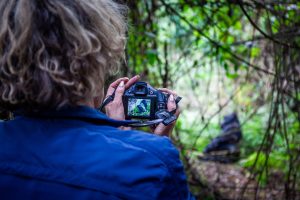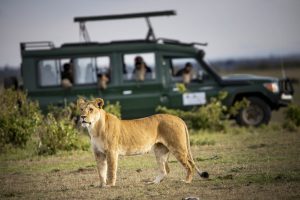Why are the beads in Kenya so important?
There are some things that are synonymous with Africa – wildlife, epic sunsets and brightly coloured beads.
In the often dry, harsh conditions of Africa’s savannahs, women’s beadwork – whether worn as a headpiece, necklace or bracelet – brightens the landscape and provides a visual highlight for tourists visiting local communities.
But in countries like Kenya, the intricate beadwork plays a far greater role than just decoration, they tell a story about the women wearing it. When you visit the arid regions of northern Kenya, the women of the Maasai, Samburu, Rendille and many of the pasturalist tribes create patterns and use specific colours in their beadwork to show their situation in life, their tribe and even their age.
Every colour in the beadwork has meaning. Green is the colour of the grass that feeds the cattle which is central to pasturalist culture. Blue is the colour of the sky and the rain which gives the land life. Red is the colour of the blood which keeps the people alive as they move across the plains. White is the colour of the milk from the cow which sustains the people during the dry season. Orange is the colour of hospitality and welcoming people into the home. Yellow is the colour of the cow skin which covers the floor of the house. Black is the colour of the people and the cycle of life.
Each woman creates a unique piece of beadwork using the colours to talk about her life. Her beadwork tells which “age set” or generation she belongs to, if she is married, how many sons she has, amongst other things. The beads are a colourful and lively part of the traditional dance and the women are able to move their necks and shoulders in such a way that make the beads dance. A woman will never leave her home without the beads that cover her neck and shoulders and such adornments can weigh up to 7 kgs.
Beads have been a part of Kenyan culture since the Arab traders first sailed down the east coast of Africa bringing glass beads from the now Czech republic. Even today, the glass beads the women use come from this region, and the women will only use glass beads in their adornments, never plastic which is considered to be inferior in quality and beauty.
While traditionally the beads help show where a person fits into the fabric of the community and shows the creativity and skill of the women developing the works. Some communities have taken the traditional art of beadwork and transformed it into a local business to provide diverse income streams.
In northern Kenya communities have traditionally relied on various activities in their environment to generate income. For generations these practices had no impact on wildlife but with more and more communities settling in one place and needing cash to pay for services such as school fees and medical clinics, some of these practices are no longer sustainable.
One traditional income stream is livestock. Cattle plays an integral role in the culture of northern Kenyan tribes but with increasing incidences of drought, large herds of cattle are no longer sustainable and start to compete with species such as the rare Grevy’s Zebra and Beisa Oryx, for grazing and water.
Grassroots organisations such as BeadWORKS Kenya have been working with the women to create beautiful beaded pieces that not only look incredible but that also provide a more sustainable income than cattle.
In this way the women of Northern Kenya are able to rely on the income from selling their beadwork rather income from livestock which means more grass and water for the northern Kenyan wildlife.
If you’ve ever travelled with RAW Africa Eco-Tours you know that a percentage of all our tours goes to helping conservation projects in the local communities we work with. And in Kenya, we support BeadWORKS.
So when you come with us on a journey to northern Kenya, we encourage you to purchase a beautiful piece of beadwork from the community or through BeadWORKS Kenya. Not only are you helping a woman generate sustainable income which keeps food on the table and children in school, you are also helping rare species like the Grevy’s Zebra survive alongside the communities of this stunning part of Africa.
Interested in travelling to Kenya? Check out our tours here, or talk to us about organising a bespoke tour for you.
Learn more about Beads for Wildlife here.







